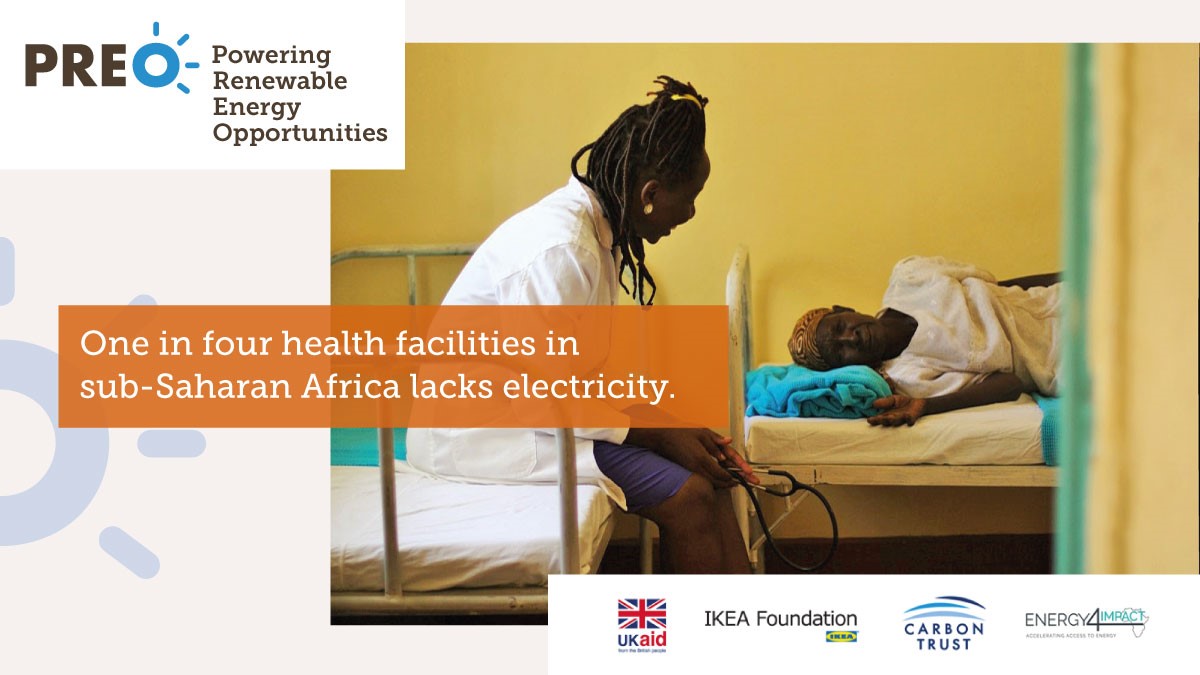PREO funding for solar healthcare solutions improves treatment outcomes in rural Kenya
Lacking reliable access to electricity, one in four healthcare facilities in sub-Saharan Africa struggle to provide quality care, resulting in poor outcomes like high infant and maternal mortality. Hospitals and clinics not only require electricity for lighting, heating and refrigerating vaccines, but also to run digital client data systems. However, information management in many healthcare systems in sub-Saharan Africa remains paper-based.
Private healthcare company Afya Research Africa (ARA) is providing off-grid healthcare centres with decentralised solar systems to improve healthcare provision in the poorest rural areas of Kenya. With solar systems in place, healthcare centres can power appliances such as lights, fridges, haemoglobin machines, centrifuges, autoclaves for sterilising equipment, servers and monitors. An in-house information management system has also been installed at clinics and kiosks to address broken health records and data systems, healthcare access challenges, clinical protocol non-compliance and accountability issues.
The work of ARA is one of several dozen action learning projects across a wide spectrum of sectors that receive funding from the Powering Renewable Energy Opportunities Programme (PREO). Supported by the IKEA Foundation and UK Aid, and delivered by the Carbon Trust and Energy 4 Impact, PREO aims to stimulate energy demand in rural Africa as a way of creating sustainable jobs and reducing poverty through economic growth.
With support from PREO, ARA’s health facilities have acquired the technology and tools to ensure healthcare delivery becomes more efficient at every stage, saving costs and time while increasing the quality of care.
As the project has been running since January 2020, preliminary results are now available from ARA. The data shows that opening hours have been hugely extended at the supported facilities: instead of 1 or 2 hours of unreliable power as was previously the norm, off-grid clinics can now typically run on full power for at least 8 hours a day and clinics with unreliable grid connection can operate on full power for at least 12 hours a day. Not only can facilities offer emergency services round the clock, patients have become more confident about visiting clinics at night. The facilities have treated greater numbers of patients, particularly women given expanded maternal care can now be provided at night. Since January, ARA has delivered 107 newborns, nearly twice as many as the year before.
A nurse at the Madiany Sub-county Hospital has testified about the impact of the newly installed solar system:
Before, we were forced to refer patients, including women in labour, to other hospitals during blackouts. Solar power enables us to work around the clock without putting patients at risk or worrying about the expensive equipment repairs caused by sudden power surge.
The new information management systems have allowed for more efficient administration and record-keeping, faster retrieval of patient information and better flow of information between facilities. Solar access has also enabled clinics to use a wider and more sophisticated range of medical appliances, such as digital blood pressure machines with subsequent improvements in the accuracy of blood pressure data.
ARA will continue monitoring clinical services and results every month. By the end of the programme in June 2021, they aim to treat at least 7,000 more patients (65% of whom will be women) and reduce operating expenditure by 20%. It is envisaged that such savings will be made by switching to solar from traditional fuels and their associated transport costs as well as no longer incurring repair charges for equipment damaged by power surges caused by unreliable grid connections. To disseminate key lessons from the programme, ARA plans to produce knowledge pieces on rolling out a health management information system and the impact of solar power on healthcare.

